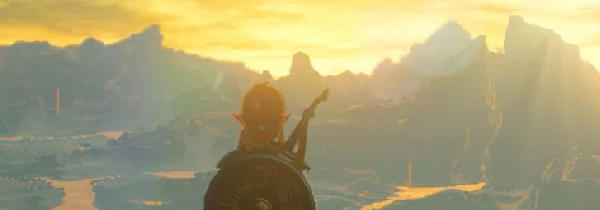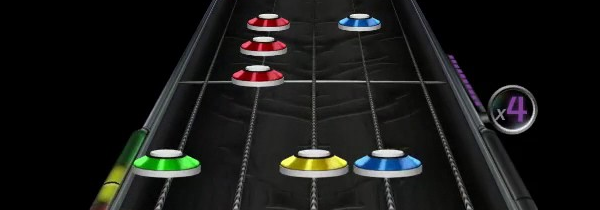
Josh Melnick – Game of the Year 2017
Josh Melnick is a freelance writer and game designer out of New York City. He spends his days finishing an undergraduate degree at NYU and his nights playing competitive games. A once top 8 placer at the Evolution fighting game championships, you can usually find him tweeting at @joshez_.

10) Tumbleseed
2017 was a great year for games that are hard to play. Not so much games that contain difficulty vis a vis Devil May Cry or Punch-Out, but games that situate themselves in your hands uncomfortably. Tumbleseed is profoundly uncomfortable. In that discomfort, though, I find myself more intensely concentrated than I do in nearly any other game. The only way I can really describe playing Tumbleseed is as what I imagine trying to navigate a cargo ship through an overpopulated bay feels like. Even dramatic re-angling of the platform has only subtle effects on your seed, but at the same time momentary twitches and bumps ripple their way to comical chains of overcompensation and eventual failure.
The process of mastery accumulation I went through with Tumbleseed has been deeply satisfying. Learning how to mentally draw a path through a series of holes and set myself up to acquire and dissolve momentum perfectly made me feel like a mad scientist. Even now, I just want to go and hit some sick slow-motion seed ollies. Perhaps the most consistent theme of Tumbleseed is that If you want to do anything, you have to earn it.

9) NieR: Automata
Most of my time with NieR: Automata was spent frustrated with myself for letting it get built up in my head so much, or disappointed in the combat, or upset at myself for thinking I could pass over large parts of the game to “Get To The Good Stuff.” I could’ve done a lot differently, could’ve dropped the difficulty to easy or looked up walkthroughs online, but I just wanted to play the game on its own terms. I was worse off for it.
Despite this, NieR was the first AAA game I played to actual completion in nearly half a decade. Somewhere along the way, it won me over. I was exhausted, worn down from high expectations, and it still managed to make me smile, and laugh, and cry. For each predictable plot point, NieR hides a dozen weird design choices.
I love the theme park filled with benign military equipment and the giant bipedal nuclear submarine’s tragic backstory and the apologetic, self-destructing, supplicating gatekeepers. I love that the most direct connection to the other game in the series is a merry wandering shopkeeper. I love that the bosses are just named after famous philosophers. I love that it stored that time I checked my phone when first presented with the options menu and replayed that still silence to me 40 hours later. It has a density of heart that was able to survive even the most dire play circumstances.

8) Everything
It can be difficult for me to gauge how much I actually like something new. Novelty is powerful, but inevitably limited. Where one finds profound import one day, they may return to find withered artifice and suspicious facade the next. In this way, the joy of discovery is uniquely all-consuming but prone to aging poorly. Everything is the essence of this phenomenon, yet it’s so dense that the slippage seems to work in its favor.
There are few virtual worlds I have been as interested in swimming through as Everything’s. I need to see every corner, every strange bit of 3D modeling that David O’Reilly committed himself to; I can’t, though. It’s just too big. The novelty of seeing things for the first time and imagining how they were made or what they can do is ceaseless, and it asks minimal effort to continue experiencing this variety.
Appropriately, it exudes this sense of bottomlessness. From its endless well, what’s old becomes new again. Animals and objects that crowded the beginning of my time with the game made themselves sparse, and finding one again a few hours in felt like a rejuvenation. I can’t really explain what Everything is or even what my time with it was like, but it is a hearty and noble thing. It is never deceitful, and always eager to share what it has found out.

7) Dota 2
Dota is one of the most rules-dense games ever made. The fact that any team (spearheaded by a myth of a human or not) is able to so consistently overhaul such a game without stepping on the careful nuances that make each of the millions of interactions crucial is unthinkable.
In 2016, Dota was at a point many considered to be the best in the history of the game. People wanted a patch, but generally, they wanted small changes to keep things fresh. Instead, they got the single largest change to the core game systems and the piece-by-piece balance since before Valve got their hands on it. It was a risky move and, predictably, it led to some turbulent patches with seemingly degenerate strategies. Somehow, after only half a year they were able to steer the game to a place where, by all apparently metrics, it was even more healthy than it was when people sang its praises a year earlier.
I will probably never stop learning Dota. The arc of it’s patch history over the course of the past year seems to mimic that of a match of Dota: starting off confused and scrambling for a foothold; gradually picking up steam, hitting a real pace in the midgame; and concluding with some smart shotcalling and a new understanding for how to navigate a game. So let me know if you want to play a game, because I won’t wait to start this queue very long.

6) Pyre
Pyre is a weird game. Ostensibly an alternate reality real-time strategy version of basketball (complete with a versus mode in the main menu [that the game discourages you from playing until you complete its visual novel-esque mode but also not too shy to present a beautiful, desolate fantasy wasteland and use it to stage a dramatic tragedy. The game features developer Supergiant Games’ trademark art style of harshly colored foreground over meticulously shaded earth-toned background and booming narration, but little else of their specific lineage. Where one can draw a clean line between Bastion and Transistor, Pyre sits more than a little askew.
As I started playing, I wanted to love each component, but was gently pushed away. Most of the characters start out pretty flat, and while the world is gorgeous to behold, it feels empty. Sparse. The slamming and dunking was fun, but it toed a scary line between tedious and frustrating. It took hours for everything to settle into place, but at some point, a few hours after making those observations, I wasn’t worrying any more. I had been taken in. Where once there were lines and fragments, now I had some sense of a whole. It’s a dangerous thing, very nearly crossing the line to discomfort, but carefully building enough structure to support a journey through to its end.

5) Super Mario Odyssey
It’s just so fucking charming. Mario Odyssey carries itself with a childlike amazement at the fact that videogames are allowed to exist. “We can just DO that?” someone at Nintendo probably asked at the idea of contrasting Mario spectrally inhabiting the body of A Literal Cartoon Piece Of Steak with him fighting a giant dragon that looks like it took a wrong turn on the way to a goddamn Harry Potter movie. The level design, the powers you have access to, the styles for each world, everything gradually becomes more outlandish as you travel across the globe in your conspicuous hat-shaped spaceship.
I know it’s a small thing, and I should have seen it coming, but the defining moment in Mario Odyssey came a bit after finishing Bowser’s Castle. It wasn’t learning that I was going to the moon, but immediately after I landed.
I jumped.
Mario went up.
He stayed up.
He stayed up a bit longer.
Then he began a leisurely trip down.
Then he landed.
I had to put down my Switch, I was laughing so hard. If you’re going to send Mario to the moon, you’re obviously going to lower gravity, but something about pushing the button and watching him float caught me off guard. There are little nuggets of joy woven into every inch of every level and strewn across each animation. It is an exuberant reminder of the kind of wonder that taught me to love games.

4) Night in the Woods
Throughout my recent teens, I became more and more detached from art that portrayed pre-adults. Everything seemed to be more interested in representing the way kids talked (but never did it well) or the setting of a school or “Coming of Age” than with any actual experiences of teendom. Night in the Woods is a rare story earnestly about people who happen not to be over the age of 25. The characters don’t talk like I do, they don’t go to school like I do, and the focus certainly isn’t on a character’s journey to become Someone Over the Age of 25. Despite, maybe because of this, Night in the Woods feels real to the life of me and my friends in a way few stories about young people do.
Really, the strength of the game is in its quiet rumination. Every aesthetic aspect of the game feeds into its wandering, lackadaisical presentation. It is calm, but excitable. Characters have pasts they’re interested in escaping, but choose to look forward rather than wave around their melodrama. Who would want to talk about their troubled past when there are fluorescent light tubes to smash and mall fountains to let loose? The picture formed is one of hope and determination, even in the face of a teen’s self-conscious existential dread.

3) Getting Over It with Bennett Foddy
I am a very patient man. To a fault, I’ve been told. Stubborn. Not necessarily innately talented enough at any one thing to justify it, but patient. If you tell me that I can, I will sit there and try until either I have or you demand that I leave.
The first time I played Getting Over It was one of these such occasions. Bennett was showing off a very early build at the NYU Game Center’s weekly Playtest Thursday. My colleagues took their turns and played, following the path that everyone took their first time. As the setting of Playtest Thursday affords, each player spent around 10-15 minutes before standing up, smiling, and sharing their thoughts with Bennett, or storming off in righteous fury.
At some point, I decided to take a turn. My progress was slow, unsurprisingly, but I did not stand up after 15 minutes. Instead, I sat there for about an hour, eventually completing what existed at the time (albeit only a small amount of the final game).
In some ways, Getting Over It was designed for me. The game demands patience and effort over any other aspect of a human soul. I’ll admit, I have had my faith tested. There was a moment where, during a piercing instant of clarity, I intentionally threw my character off the mountain just to do it again. Still not sure why I did that, I think I pre-empted it by explaining to those around me that I just wanted to hear the sad music again.
The road is long and restless, and the crass narration ceaseless, but as long as the top of the mountain exists, I am compelled to see it.

2) The Legend of Zelda: Breath of the Wild
I did not beat Breath of the Wild and I don’t think I ever will, but that cannot stop it from being one of my favorite games of all time.
Breath of the Wild is, as presented, lesser than the sum of its parts. A Zelda game, in the traditional context for discussion, is a series of environments, dungeons, and puzzles upon which a castle is raided and a princess saved. Only one of those things in Breath of the Wild remotely appeals to me.
Instead, my Breath of the Wild is an endlessly wide and miraculously deep landscape, filled with things and people and food and mystery. I spent the first ten hours of the game spotting towers on the horizon and marching directly between them. I examined almost nothing between them, instead furiously taken with the notion of unlocking the full map. This completed, I opened up my map, marked a location with a funny looking pattern of trees and contour lines, and explored.
My following 30-40 hours of gameplay consisted of wandering. I accidentally stumbled into one of those memories and a series of story missions and a traditional Zelda dungeon, but those experiences pale in comparison to the unplanned fights with giants, my definitely-unintended swim-nudging a magic ball around a spiral to avoid combat, a tour of forgotten ruins and abandoned caves.
The very thought of having to engage with characters who would seek to guide my hand terrified me. I stared at a skull shaped mountain and prayed to god that no plot-stricken lump would demand I visit it. When I saw an unknowable forest, I rushed to it for fear that some nagging quest log would eventually spoil my fun. Each corner held wonder and I lost myself between them, only to find more.
Luckily, the interruptions were few. My six year-old brain found a successor to Link’s Awakening that understood that seeking is only fun when someone is, in earnest, hiding. I only thank god Breath of the Wild stayed out of my way long enough for me to adore it.

1) Clone Hero
It’s hard to argue that there is anything new about Clone Hero, per se, but in that, it represents the perfect culmination of an experience that has been sloppily accumulating on itself for over a decade. Clone Hero is the current incarnation of what people broadly refer to as “Guitar Hero.” Descendent of, but distinct from Guitar Hero (the series of videogames first released by Harmonix in 2005), “Guitar Hero” is the abstract collection of design elements that constitute Guitar Hero, Rock Band, Frets on Fire, and maybe even Rocksmith.
To understand the importance of Clone Hero, one must have brief context for its circumstances and who plays it. While Harmonix and Red Octane have been producing songs and respective maps of notes (cumulatively known as charts) for over a decade, as soon as people were able to rip these games on their PC’s, so too have community members. Charting is as much an art as designing levels in Super Mario Maker and has found itself as an expressive outlet. From trying to make the hardest charts (for some concept of coherence and possibility) to Steamed Hams, people do interesting work through this strange medium.
For a long time, the main way to play custom songs was by reverse-hacking them into Guitar Hero 3‘s PC port. This sucked for a few reasons: Guitar Hero 3 PC was never released digitally; importing each song was a big of a technical headache; once you got used to that, the game actually had a song limit, forcing players of custom songs to design and distribute a second hack to overcome that (also a hassle in its own rite).
Then, Srylain released Clone Hero. Built from the ground up to maintain Guitar Hero 3′s feel, but independently optimized for ease of custom song importing, customization, and livestreaming. Suddenly, the thousands of custom charts people had been making were easily available for anyone to play. It’s not perfect, for sure, but there is a truly disgusting amount of incredible work out there that you only need a cheap plastic guitar to get to.
I could go on about how Clone Hero’s specific feel-oriented design decisions have led to my favorite “Guitar Hero” game of all time, but the access it provides to a wealth of bizarre artistry is honestly enough to earn this spot. Someone please contact The Library of Congress, the people need to know.





